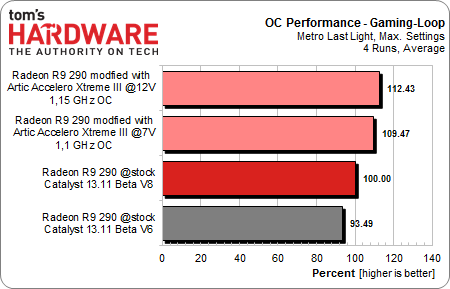Fixing The Radeon R9 290 With Arctic's Accelero Xtreme III
One of the best things we did for our Radeon R9 290 review was pop off AMD's reference cooler and attach Arctic's Accelero Xtreme III. Today, we show you how we did this, we dive deeper into the results, and ultimately recommend the aftermarket heat sink.
Temperatures, Overclocking, And Noise
Overclocking And Temperatures at 12 V
So, let’s test the real limits of this card's frequency. We can always dial the acoustics down later. With the R9 290's power limit set to +35%, I figured out that the maximum stable clock rate was somewhere around 1150 MHz using an hour of Metro: Last Light looping 24 times. It only took 10 minutes for each pass to hit its highest temperatures, and I maintained constant clock rates throughout, so there was none of the jumping up and down seen from AMD's reference cooler.
The following chart tracks thermals for the GPU and voltage regulators at two different clock rates.
Overclocking And Temperatures at 7 V
Now we know our overclocking limits (on air, anyway). What happens to the voltage regulators when we dial back fan speed with a 7 V adapter, though? It turns out that GPU stays nice and cool, but the VRM overheats. To maintain safe parameters, we measured everything again at a 1100 MHz ceiling and a +20% power limit. The 1150 MHz we were enjoying before is still possible, but then you're looking at almost-100 °C voltage regulator temperatures.
Real-World Performance Improvement
All of this adds up to an improvement in gaming, quantified by measuring average frames per second. Otherwise, a higher sustainable clock rate on its own doesn't mean much. You'll have to forgive the results with AMD's Catalyst 13.11 Beta 6 and 8 drivers. These numbers were all run before the company adjusted its fan control algorithm in the face of our investigative work.
Between when we received our original press board with AMD's original driver and our more recent overclocking effort using Arctic's Accelero, the Radeon R9 290 picks up nearly 20% more performance. Even after the Beta 8 driver with a 47% PWM limit, the modified card wins by 13%. Of course, by pushing the 290's fan speed even higher using Catalyst 13.11 Beta 9, AMD managed to eke out addition performance. At the same time, however, it made a very loud thermal solution even louder. clock speed gain. Arctic's Accelero Xtreme III gives you even more speed, without the unbearable whining.
Video Comparison Of The Aftermarket And Reference Cooler
First we're going to let you listen to both overclocked versions of our R9 290 with Arctic's cooler at 12 V (1150 MHz) and 7 V (1100 MHz). Then, you can check out the original Radeon R9 290 with its 47% PWM limit that was knocking our press card back off of its 947 MHz ceiling. Remember, Catalyst 13.11 Beta 9.2 makes the board even louder.
We present AMD's Radeon R9 290 GHz Edition, the way it should have been.
Get Tom's Hardware's best news and in-depth reviews, straight to your inbox.
Current page: Temperatures, Overclocking, And Noise
Prev Page Assembly And Operation Next Page No Surprise: Arctic's Accelero Xtreme III Is Recommended
Igor Wallossek wrote a wide variety of hardware articles for Tom's Hardware, with a strong focus on technical analysis and in-depth reviews. His contributions have spanned a broad spectrum of PC components, including GPUs, CPUs, workstations, and PC builds. His insightful articles provide readers with detailed knowledge to make informed decisions in the ever-evolving tech landscape



